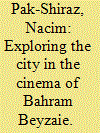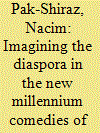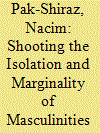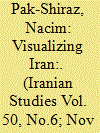| Srl | Item |
| 1 |
ID:
126933


|
|
|
|
|
| Publication |
2013.
|
| Summary/Abstract |
This article explores five of Bahram Beyzaie's urban films over the last four decades to study their critique of the process of modernization and social changes that have taken place in Iran. These include The Journey (Safar, 1972), The Crow (Kalagh, 1977), Maybe Some Other Time (Shayad Vaqti Digar, 1987), Killing Mad Dogs (Sag Koshi, 2001) and When We Are All Asleep (Vaqti Hame Khabim, 2009). It examines the impact of modernization on the architecture and landscape of the city and consequently on the local community. It then studies the increasing complexity of ascertaining the real and unreal within the city. Finally, it looks at the changing values, the fears and threats within the city and the impact these have on its inhabitants, particularly women and their movement within the city.
|
|
|
|
|
|
|
|
|
|
|
|
|
|
|
|
| 2 |
ID:
120856


|
|
|
|
|
| Publication |
2013.
|
| Summary/Abstract |
This article examines the genre of comedy in Iranian cinema and explores the various influences on its development and growth. It demonstrates how the roots of recent comedies can be traced back to pre-Revolution commercial cinema (known as filmfarsi) as well as the traditional Iranian comic theatre of taqlid. In particular, it focuses on the depictions of the Iranian diaspora in these comedies. The Iranian diaspora has been imagined and represented frequently in modern Persian culture, often satirically and humorously. More recently, Iranian comedies have provided a new space to imagine, define, criticize and redeem the Iranian diaspora.
|
|
|
|
|
|
|
|
|
|
|
|
|
|
|
|
| 3 |
ID:
155086


|
|
|
|
|
| Summary/Abstract |
This article examines the isolation and marginality of Iranian men living in contemporary Iran with a focus on three post-2005 films. As a patriarchal society, Iran has been the subject of many studies on the subjugation and marginality of women. This study demonstrates how recent Iranian films have skillfully employed the cinematic language to narrate men’s stories of alienation and despair. These filmic constructions provide a valuable and complex insight into masculine identities, challenging perceptions of the essentialized image of the Middle Eastern male. By employing Connell’s hierarchy of masculinities, the article demonstrates the position of marginalized men in relation to the dominant ideals of masculinity and the influence of these discourses on the lives of such men. The films discussed here do not perpetuate the construction of the ‘true’ gender, but instead challenge ideas of heroism, manliness and patriarchy.
|
|
|
|
|
|
|
|
|
|
|
|
|
|
|
|
| 4 |
ID:
155078


|
|
|
|
|
| Summary/Abstract |
This special issue brings together eight articles that examine the visualization of Iran ranging from the Achaemenids to contemporary Iranian society, providing a glimpse into the array of representations in and of Iran. Even as a snapshot they allow a bird's-eye view of the historic role of visual culture in shaping, influencing, and transforming Iranian cultures over successive centuries. An immensely rich visual culture has always existed in Iran and the surrounding regions, often shaped by encounters with different zones of contact and patronized by ruling elites and dynasties with myriad artistic and cultural traditions, needs, and agendas. This special issue is a tribute to that rich cultural history.
|
|
|
|
|
|
|
|
|
|
|
|
|
|
|
|